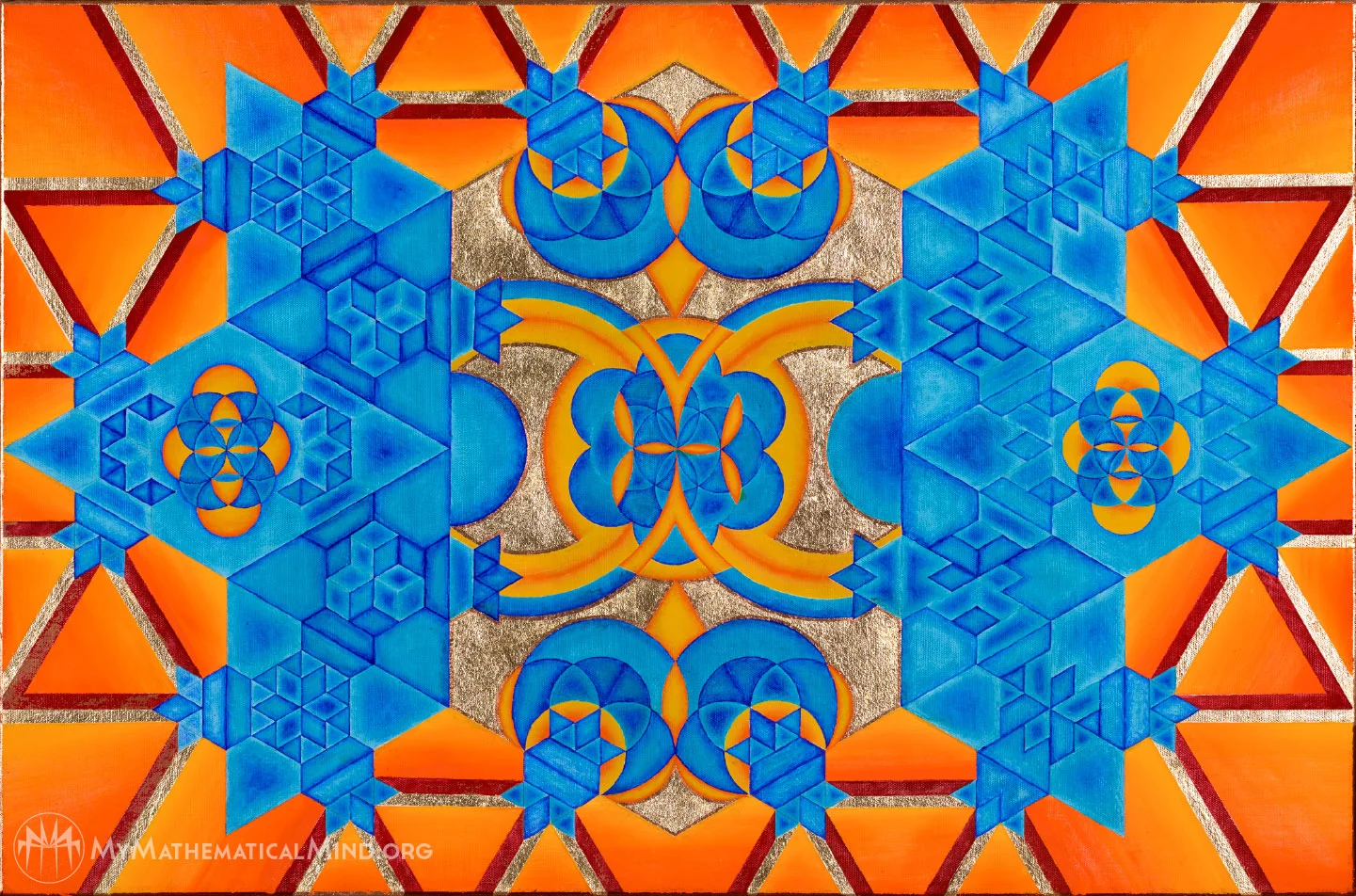
くへ - Kuhe
18"x36"
Feb 2, 2012
Acrylic and gold leaf on canvas.
Ltd Edition Size: 48
To create Kuhe, the canvas was sectioned into a square standing on its corner in the middle with 6 triangles around it. Then each of these shapes were progressively nested inside of themselves rotating a bit each time. The result is an image with a total of zero curved lines. See if you can find the original shapes!

しち - Shichi
24"x36"
Jun 11, 2013
Oil and gold/copper leaf on canvas
Ltd Edition Size: 34
Shichi began its existence as a diamond. Two equilateral triangles stuck back to back to be precise. From there, a simple rule was applied: on the middle of each side, place another diamond and then repeat the process. Several repetitions later Shichi blossomed into something unexpected and exciting!

たの - Tano
24"x36"
Feb 18, 2015
Oil and gold leaf on canvas
Ltd Edition Size: 36
Tano is sort of a mish-mosh of mathematics. Instead of one continuously repeated pattern, it makes use of several alongside some basic geometrical shapes. Emanating from the centralized triangle you will find 12 instances of the trigonometric sine function. The mathematical formula for each of these can be written specifically as: y = x∙sin(x)/√3.

とれ - Tore
12"x60"
Feb 20, 2015
Digital Work of Art
Ltd Edition Size: 50
Tore was originally designed to adorn a snowboard. The center is a fractal based on nesting hexagons within each other and the nose/tail patterns are nestings of equilateral triangles affectionately known to mathematicians as "Sierpinsky Triangles."

きた - Kita
36"x36"
Mar 4, 2015
Digital Work of Art
Ltd Edition Size: 30
Kita is based upon the golden ratio and the Fibonacci spiral. Starting with a large square, two vertical and two horizontal lines were drawn. This created four small corner squares, a center square, and 4 rectangles around the side. The lines were drawn in such a way that the resulting rectangles were proportioned in the golden ratio. The entire pattern was then repeatedly nested within each of the new squares.

へれ - Here
20"x20"
Mar 18, 2015
Digital Work of Art
Ltd Edition Size: 28
While technically not being a fractal, "Here" certainly had simple beginnings: It began as a circle. This inner circle was surrounded by a ring of equal circles. Which in turn were surrounded by one final ring of circles. Finally, the center of each circle was connected to the center of each other circle. This mathematical object famously known as "Metatron's Cube" has the interesting property that it contains images of all five of the platonic solids.

めそ - Meso
20"x20"
Apr 8, 2015
Digital Work of Art
Ltd Edition Size: 32
Ever folded a piece of paper in half a couple times and then unfolded it to see what shape it makes? If you have, then you have created a simplified version of Meso yourself! The seemingly random outline in this image is created from repeatedly "unfolding" line segments by 90 degrees. In mathematics, this object is known as the "Dragon Curve." A wonderful example of complexity springing from simple roots.

れき - Reki
24"x24"
Apr 11, 2015
Digital Work of Art
Ltd Edition Size: 38
Reki starts as a pentagon. Connecting each of the corners yields the familiar five pointed star used by the Pythagorean mathematical society in ancient Greece. Now the pentagon has been sectioned into the five triangles forming the star, a smaller center pentagon, and five remaining triangles. The triangles are filled with fractals known as the "Sierpinsky Triangle" and the "Apollonian Gasket." Finally the entire piece is nested inside of the interior pentagons repeatedly.

ゎへ - Wahe
36"x36"
Apr 14, 2015
Digital Work of Art
Ltd Edition Size: 32
Wahe could be termed a hyperbolic geometry fractal. This geometry is a bit different than the Euclidian geometry that we are typically exposed to during our math education. In hyperbolic geometry, straight lines actually appear as curved to us. Because of that, each apparent "semi-circle" on this piece is actually considered to be a straight line in the hyperbolic realm. If this seems otherworldly, I assure you that it's not. The hyperbolic version of geometry can be seen in the real world in creatures such as sea slugs and coral reefs!
Niji Series









